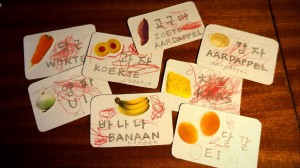An almost three-year old girl draws on everything. Miru takes her color pencils and makes her mark on the vocabulary cards that her mother has prepared for her early childhood education. Her third birthday is less than a month away and we think it’s great when she learns a lot now, while her need to turn everything into play is not yet negotiable. With her color pencils, she paints her world with blissful ignorance, unaware of climate change, religious fundamentalism and the excess that capitalism has become.
How long will this last?
Gradually she discovers shapes. A scribble becomes a line, a line becomes a circle. Soon she will be drawing faces that stare back at us. Then she will paint emotion on these faces. And her faces will appeal to us. She will be able to give the empathy she already feels a place in the world. The nondescript “apo” (ouch) that she utters now when she sees animal corpses on display in the supermarket, will turn into a confronting voice of conscience.
I can imagine how some parents fear this stage of their toddler’s development, but I am looking forward to it. Since my twenties I haven’t been morally challenged. I have developed my arguments like habits, and they have grown dear to my heart. I have internalized my opinions with little room for the kind of rigorous self-criticism that has a prospect of changing these habits.
Miru will develop her own voice, which means she will assume a moral authority. In a few years time she will be able to ask me the type of question that can make moral convictions shake.
When a six-year-old girl says “but I feel it’s wrong” we should listen carefully.
 Miru is half that age. Her moral compass is still tilting but tends to point to meio, mine. But she strictly applies the same rules to her parents (interestingly enough, she doesn’t judge strangers): papa, 조심해, stoep! (careful! sidewalk!). This rigorous mirroring of the concept of a rule, the discovery that she can apply it to these two large humans that are always there. It is the beginning of her morality.
Miru is half that age. Her moral compass is still tilting but tends to point to meio, mine. But she strictly applies the same rules to her parents (interestingly enough, she doesn’t judge strangers): papa, 조심해, stoep! (careful! sidewalk!). This rigorous mirroring of the concept of a rule, the discovery that she can apply it to these two large humans that are always there. It is the beginning of her morality.
She doesn’t actually draw on everything, but on enough surfaces that make it troublesome for her parents. We chase her with an eraser. The simple rule “don’t draw on that” is confusing when she sees her mother drawing. We can’t explain her the difference between a paper and a wall, or a finished educational card.
But I’m sure my little girl will soon understand and develop a sophisticated sense of rules and right and wrong that she can and will apply critically to the world around her.
The writing is on the wall.
